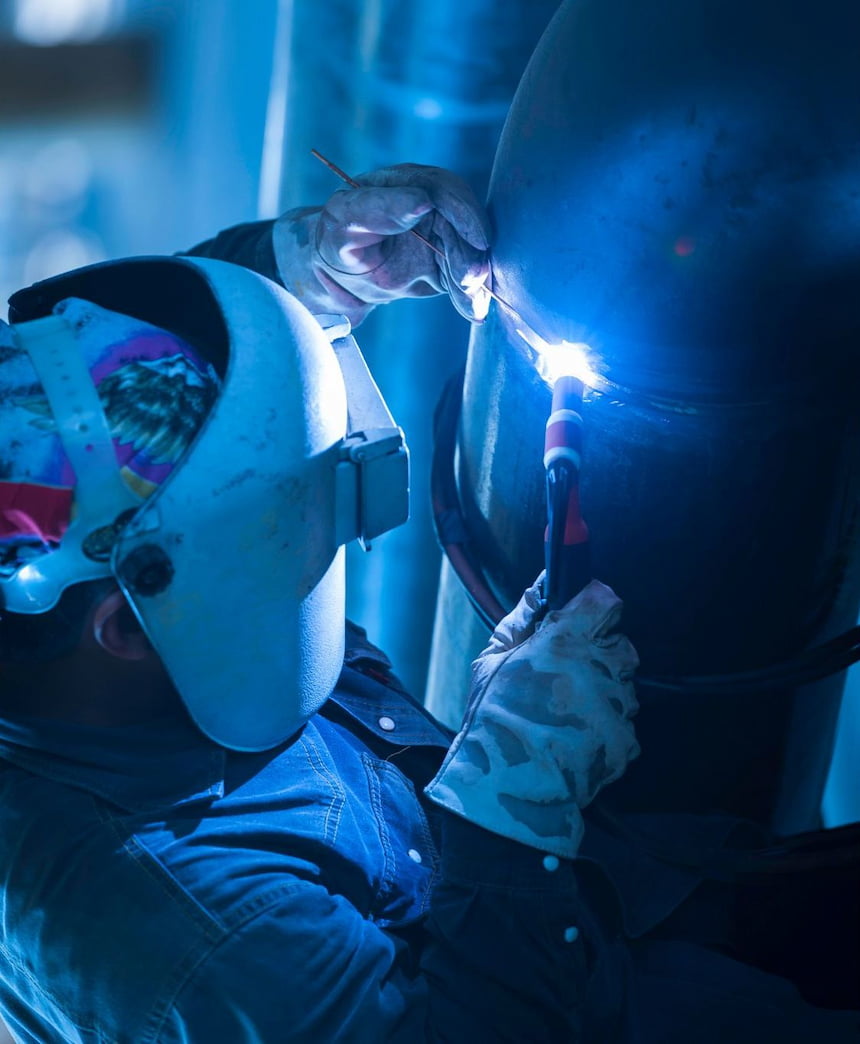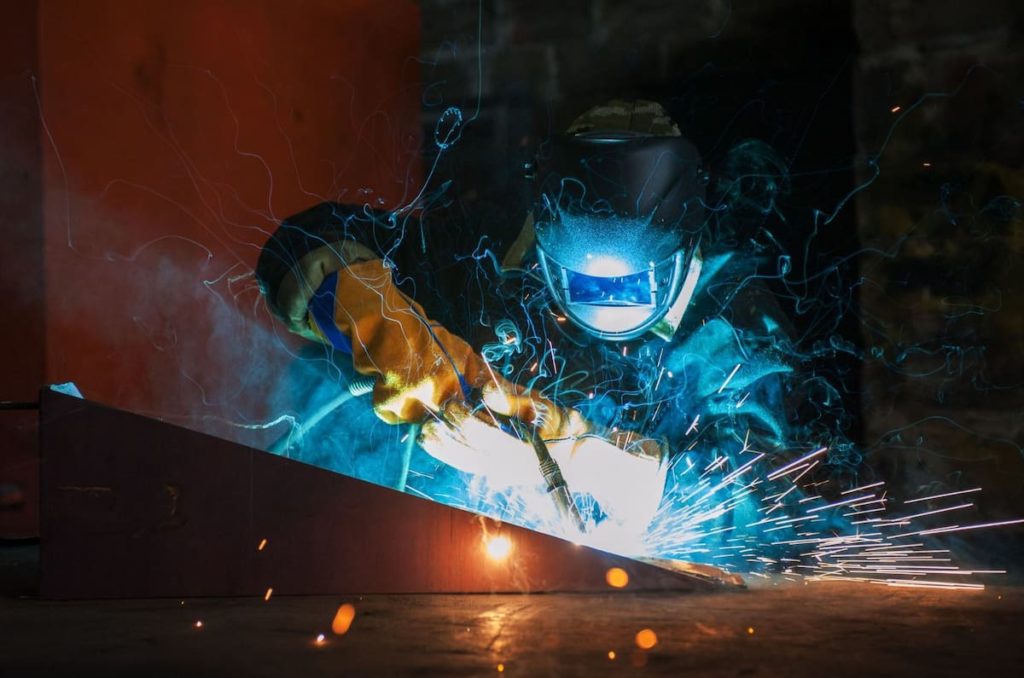Are you interested in mastering the skill of welding a weld overhead and welding wire together? Do you want to learn more about this complex yet rewarding process and how it can help improve your welding projects? Look no further.
Table of Contents
In this article, we’ll give an overview of what overhead welding is all about, provide tips on getting started, and discuss why it’s such a versatile welding technique too. Whether you are a novice or an experienced welder, understanding all the difference and fundamentals of welding from any angle is essential.
Overhead Welding – What It Is and Why It’s Necessary
Overhead welding is used to join metal components in an overhead position. This method is often employed when working with thick or heavy materials, and it allows the user to complete the job without having to constantly adjust their posture or manipulate the object into awkward positions. This can save time and energy, making it an ideal choice for large items.
In addition to speed, the ability to work flat welding while in an overhead position makes it possible to access areas difficult or impossible to reach by other conventional welding methods. This can make a big difference when working on projects requiring a lot of precision and accuracy.
Regarding overhead welding, two types of processes are available: backstep and top-down overhead welding techniques. Backstep is the most common type of overhead welds, as it’s usually easier for beginners to learn. Top-down, overhead welding technique requires more skill and experience so this article won’t cover it.

Types of Materials Used for Overhead Welding
As mentioned, the overhead welding technique is often a technique used to join thick or heavy materials because it can provide a stronger weld than other methods. When selecting the right material for your project, remember that the type of metal you choose will also determine the strength and durability of the result.
Common metals used for overhead welding include steel, aluminum, cast iron, stainless steel, and copper. While these metals are the most commonly used in overhead welding projects, other materials can be welded. It’s important to consider the thickness of the material when making your selection to ensure it will result in a strong and reliable joint.
Also, remember that some metals may require special techniques and protective gear for overhead welding. In particular, aluminum and stainless steel can be difficult to weld with standard welding equipment, so having the right tools and safety gear on hand is important when joining those materials.
Tools and Equipment Needed for Successfully Completing Overhead Welding Projects
Overhead welding requires a few specialized tools and supplies, some of which may not be readily available in your toolbox. Before beginning a stick welding or overhead weld on part project, you should ensure you have all the necessary items to ensure a successful outcome.
At a minimum, you will need access to an arc welder or TIG welder and a safety shield. If you don’t have access to one of these machines, they can be rented or purchased from a local welding supply store.
Depending on the materials, you may also need additional protective gear, such as gloves, safety glasses, and a welding mask. In addition to the tools already mentioned, overhead welding projects may require additional items like a welding rod, flux-cored wire, and a welder stand.
A welder stand is especially important for projects needing extra stability or for those that have heat or require you to work at heights difficult to reach without the help of gravity or a sturdy platform. As with any welding project, it’s important to read all safety instructions before beginning work, as overhead welding can be hazardous if not done properly.
Tips and Tricks for Safe, Effective Overhead Welding
Now that you’re familiar with the basics of overhead welding and have gathered all the necessary supplies, it’s time to start. Here are a few tips to ensure a successful outcome:
1. Speed of Travel
It’s important to find the right travel speed for molten metal dripping your welding rod. If you move molten metal too slowly, you’ll have problems with spatter and poor weld integrity. Too quickly, you risk an incomplete joint or you create a weak bond between the two pieces of molten weld or metal together.
2. Voltage – Controlling the Arc Length
To get a strong weld, it’s important to create enough heat and maintain the heat at the proper arc length between the welding rod and the workpiece. This can be done by adjusting the voltage on your welder until you achieve the desired weld result.
3. Electrode Size
The size and type of welding rod you use will also affect the quality wire speed of your side welds. If you’re using an arc welder, select a rod with the same amperage rating wire speed as your machine for best results.
4. Shielding Gas Flow Rate
If you’re using a TIG welder, setting the correct flow rate for your shielding gas is essential. If it’s too low, you may have issues with porosity and poor weld fusion. Too high can lead to uncontrollable spatter and unstable arcs of heat.
5. Welding Gun Angle
For optimal penetration, it’s important to maintain the correct angle between the nozzle of your welding gun or nozzle and the workpiece. The ideal nozzle angle is usually between 10 and 30 degrees, depending on the thickness of the material.
Common Mistakes to Avoid While Performing an Overhead Welding
Improper welders joint preparation: Failing to properly prepare the weld bead and joints can lead to poor penetration and an uneven surface finish the weld bead, resulting in a weak weld.
Not using the correct wire or right welding rod: Selecting the wrong type or wire feed speed of welding rod can result in an inadequate weld that won’t last. Insufficient shielding gas: When working weld metal together with wire feed a TIG welder, you must ensure wire feed the welders the right amount of shielding gas to produce a clean and strong weld.
Moving too quickly or slowly: Finding the correct travel speed for molten metal on your welding rod can be tricky, but a full speed or slow travel speed for achieving a good weld is essential. Not using the right angle: If you position your welding gun in position that isn’t at the right angle to the workpiece, control, penetration, and fusion of weld, will be compromised.

FAQs
What are the benefits of overhead welding?
Overhead welding offers benefits, including improved safety when welders are welding overhead, or working on high surfaces, greater access to difficult areas, better control, and stronger welds due to thicker materials.
What materials can be used for overhead welding?
MIG welding (Metal Inert Gas Welding) is a popular technique in welding, especially for overhead applications. When performing MIG welding overhead, the right shielding gas can make all the difference. Shielding gas helps to protect the weld from atmospheric contamination and prevents oxidation of the metal being welded. It also creates a more stable arc and produces a higher-quality weld.
The most common materials used in overhead MIG welding are aluminum, stainless steel, mild steel, and copper alloys. Each material has its own unique shielding gas requirements, and selecting the correct one is essential to ensure a successful weld. Generally speaking, argon is the most widely used shielding gas for MIG weld overhead as it provides the best arc stability and penetration.
How do I weld overhead?
You’ll need to use an arc welder or TIG welder and a safety shield to keep welders from overhead. Depending on the materials used, other protective gear may also be necessary. Additionally, you must ensure the right position and travel speed for the wire on your arc welding rod, select the appropriate welding rod, and set the correct flow rate for your shielding gas.
